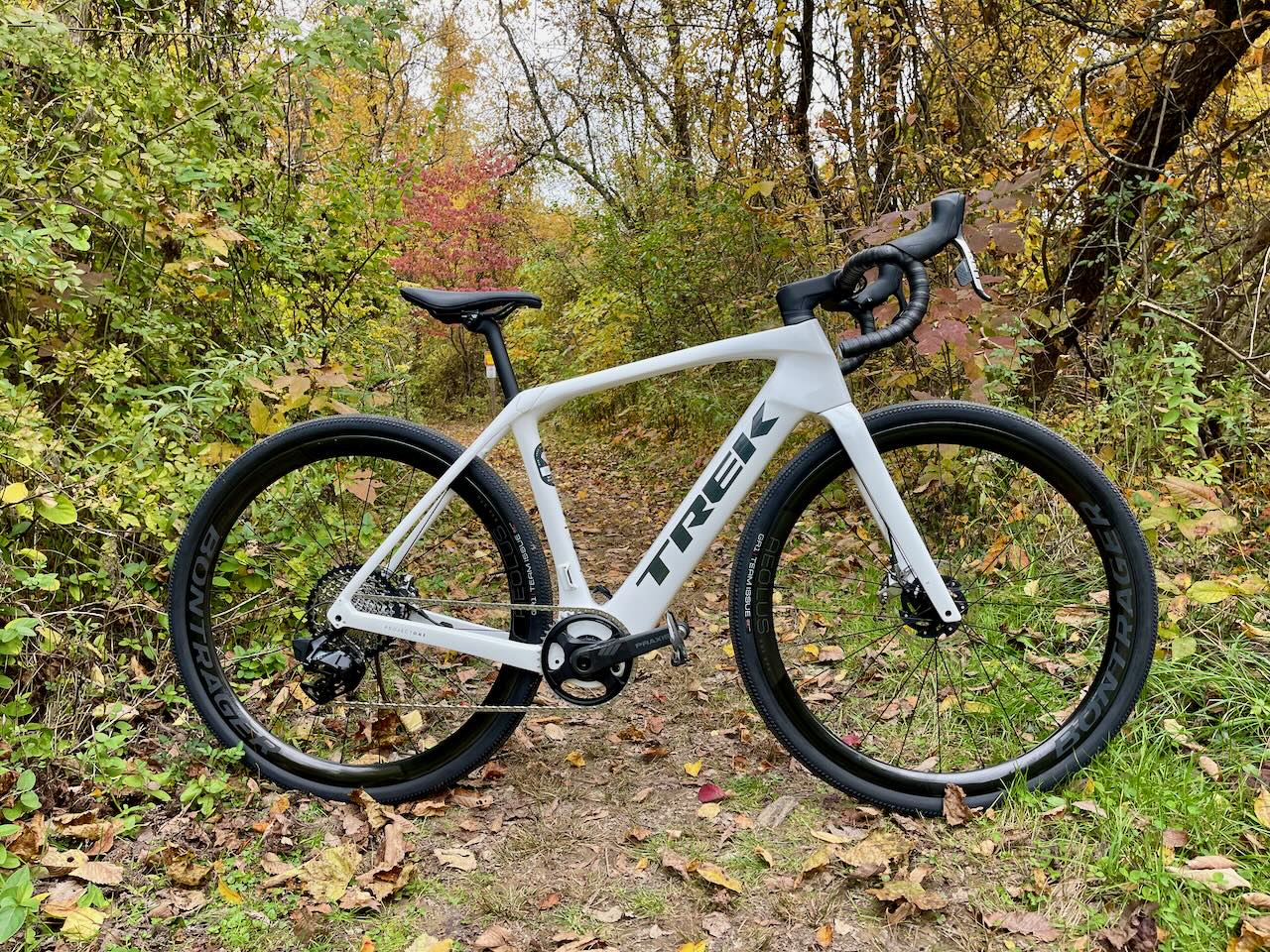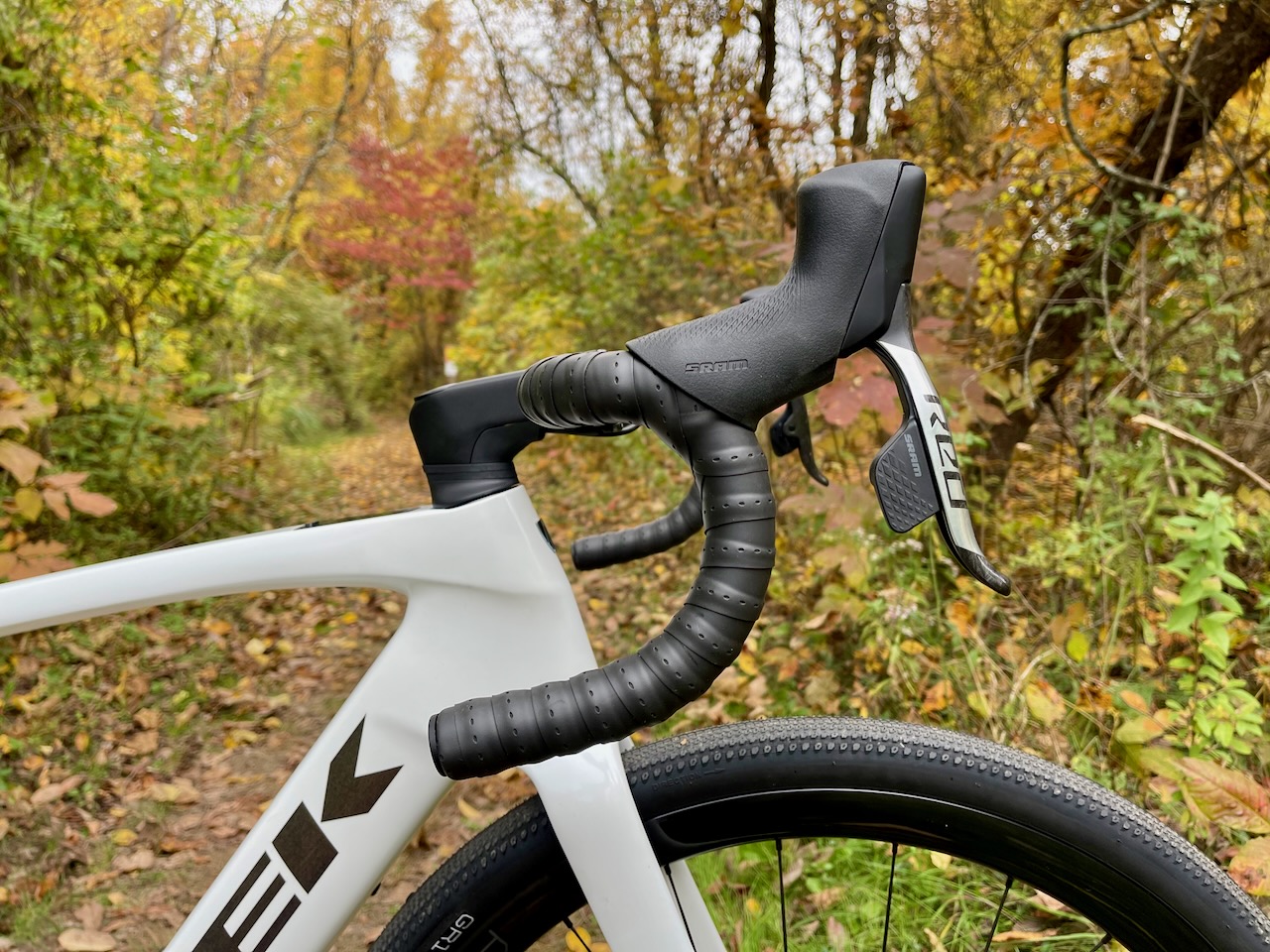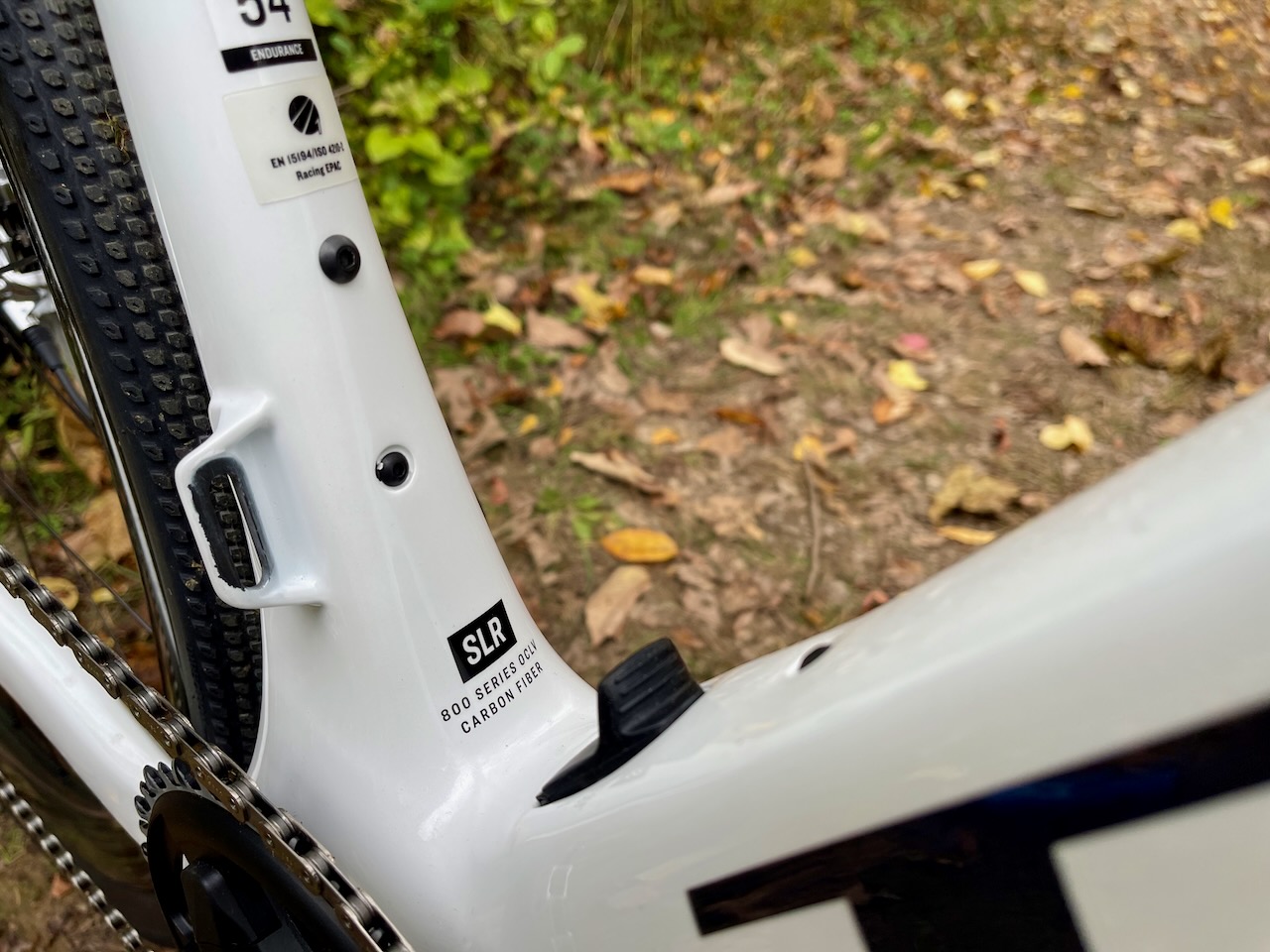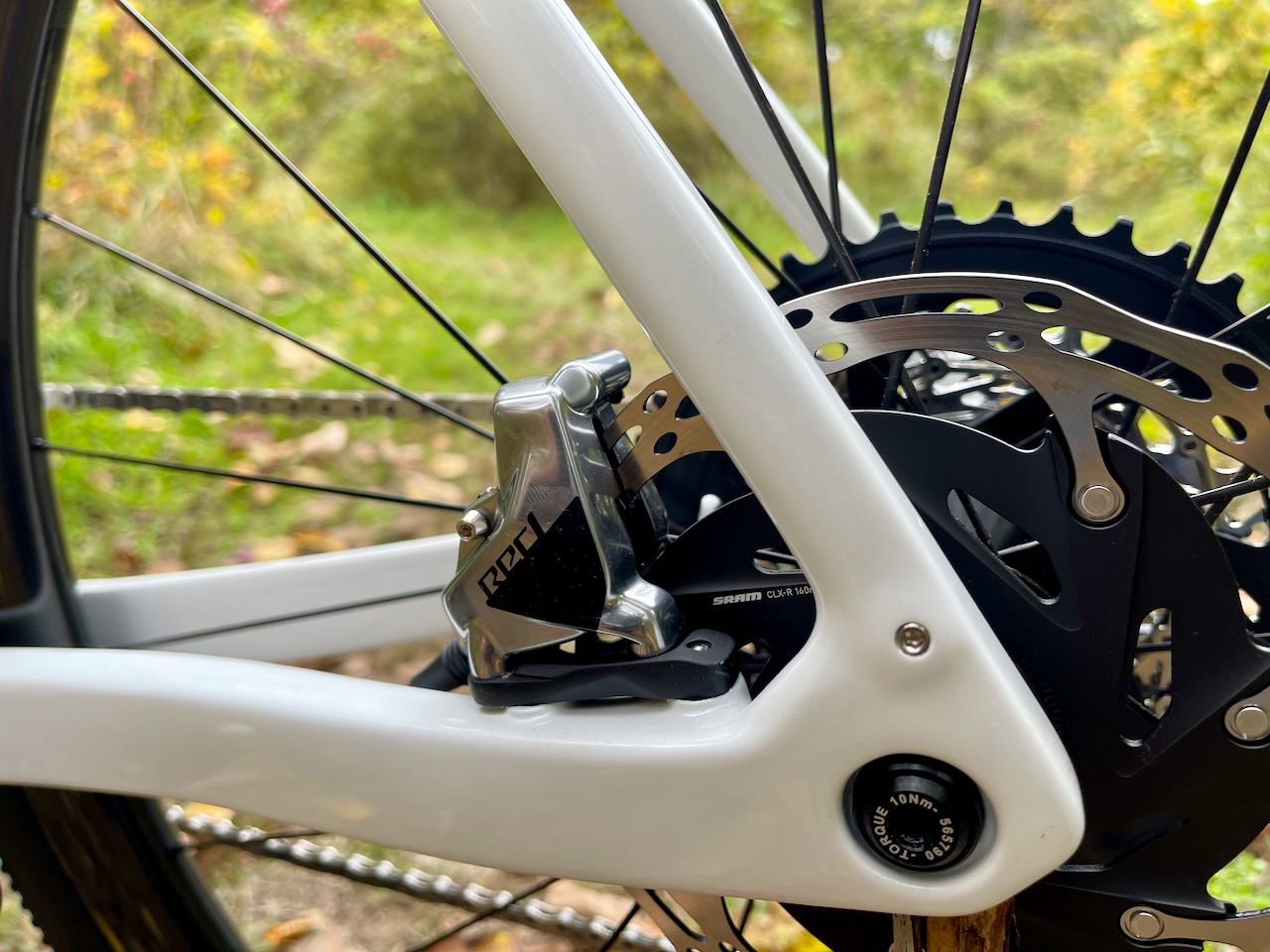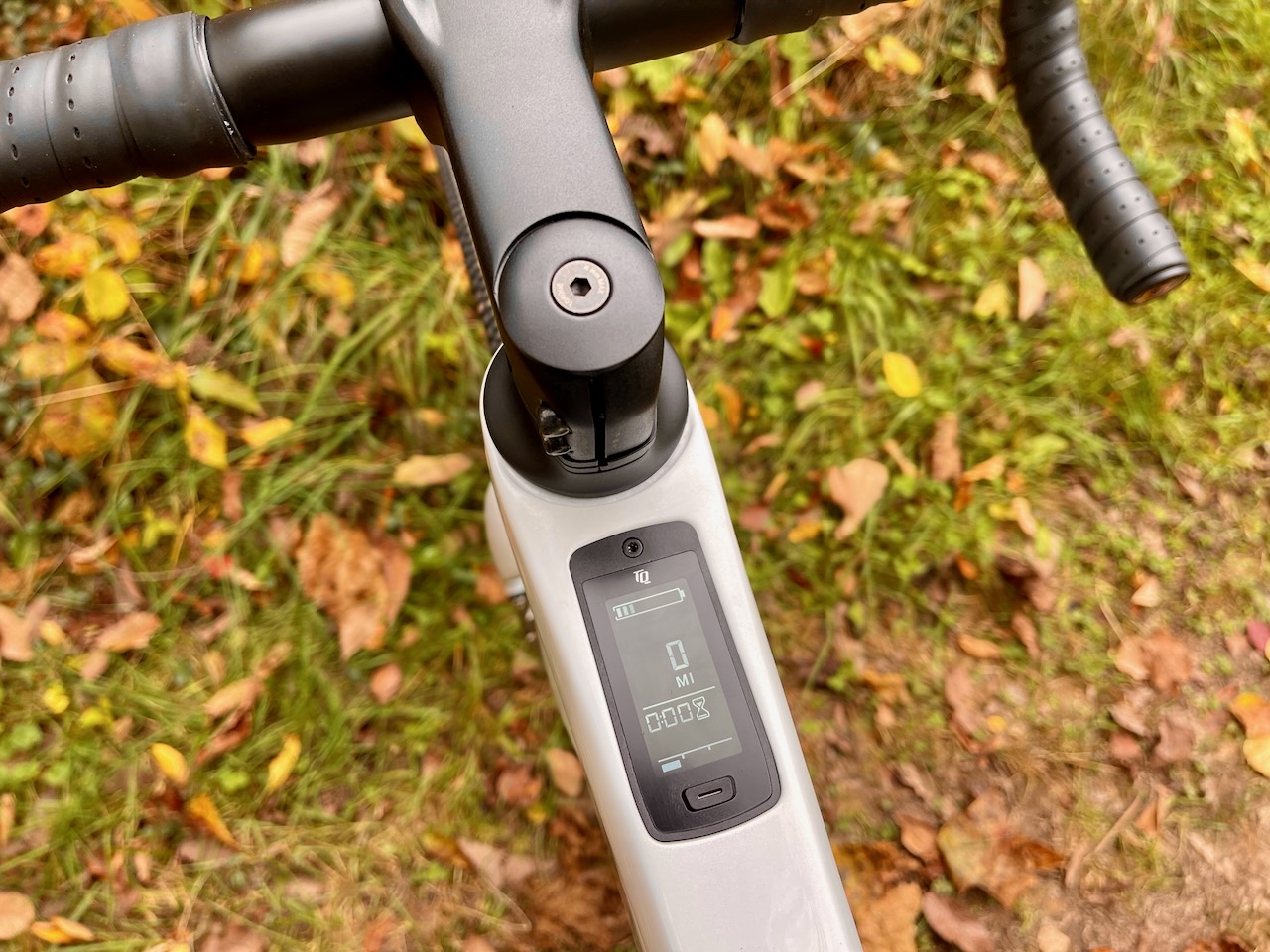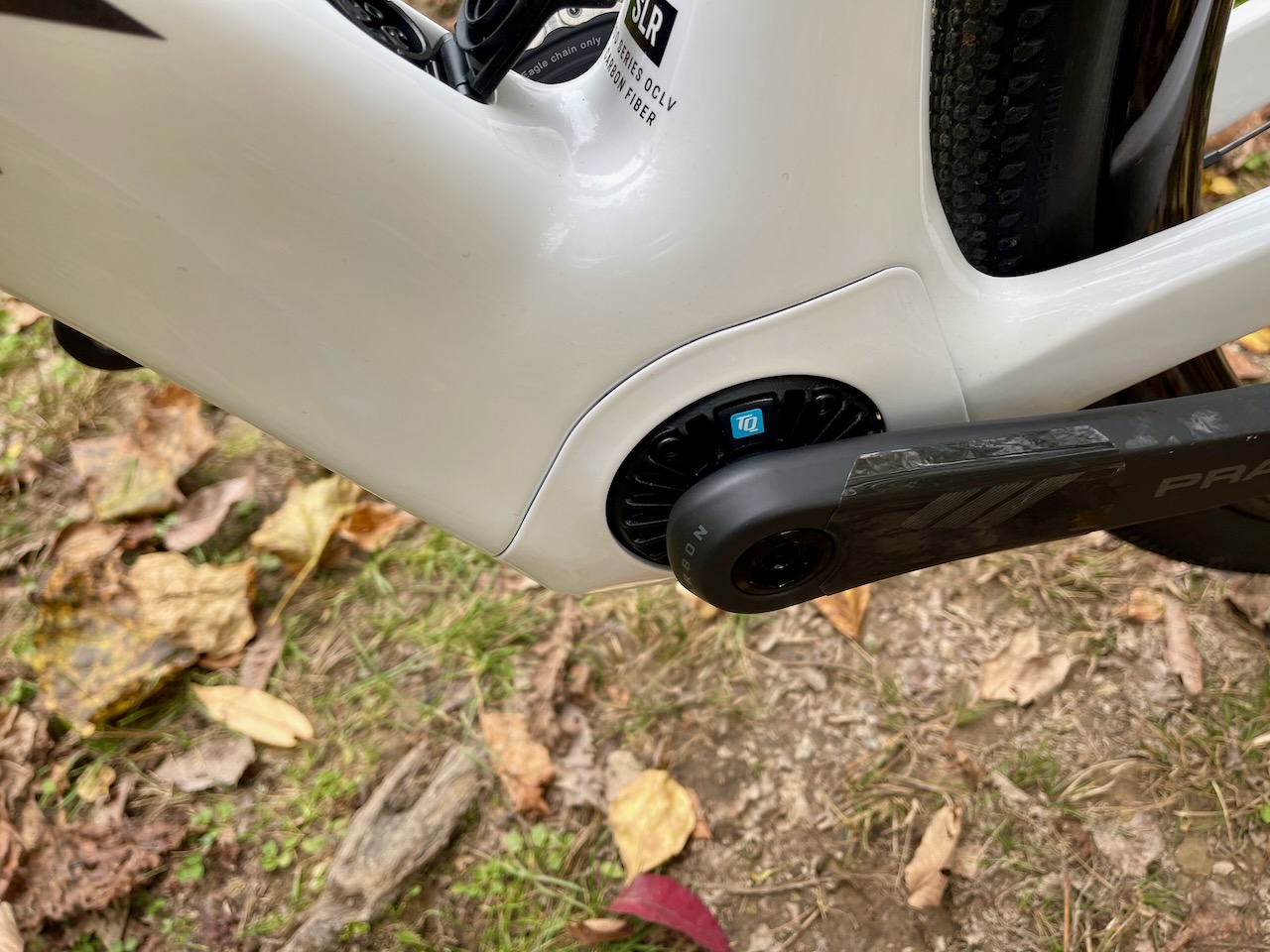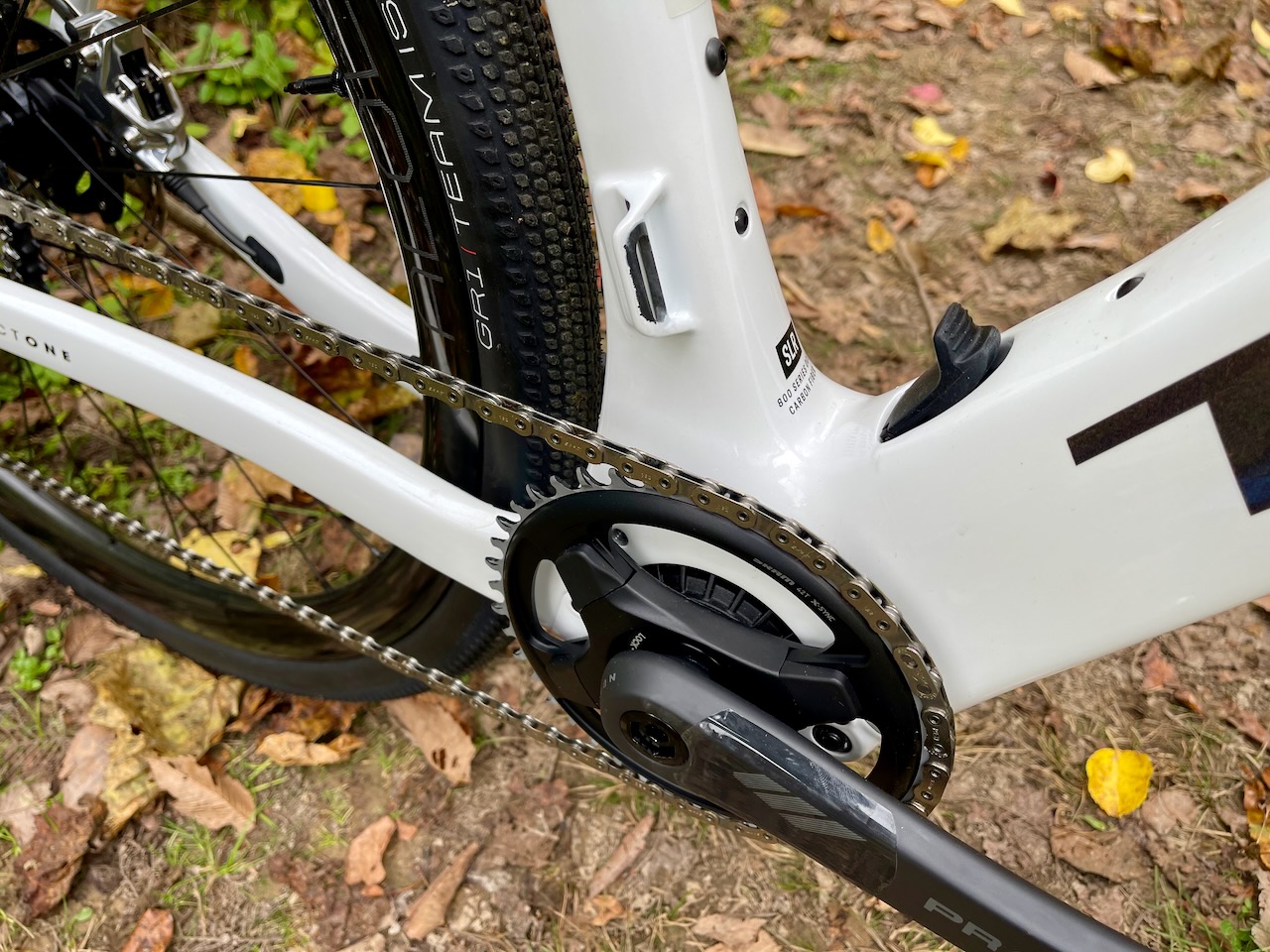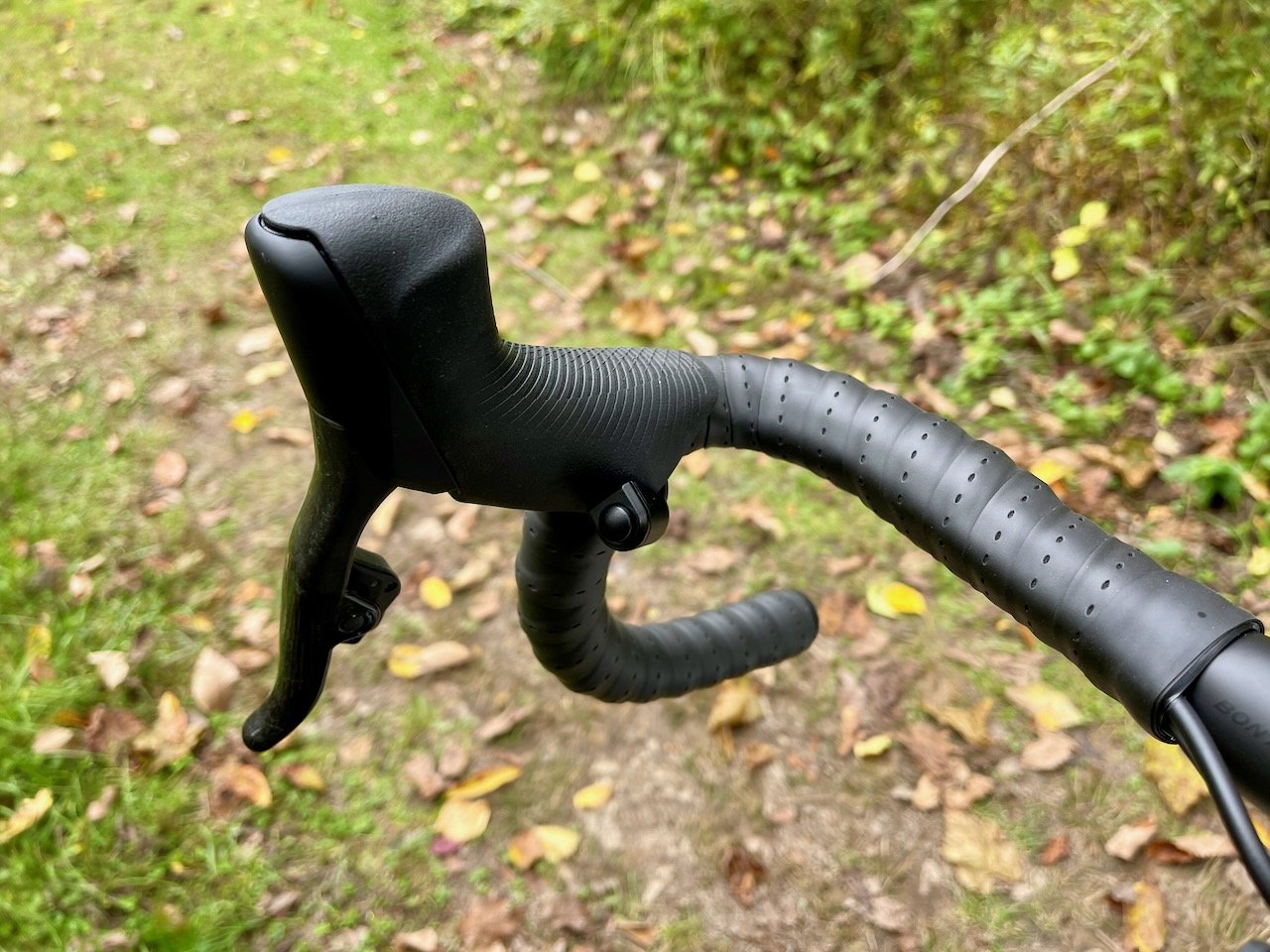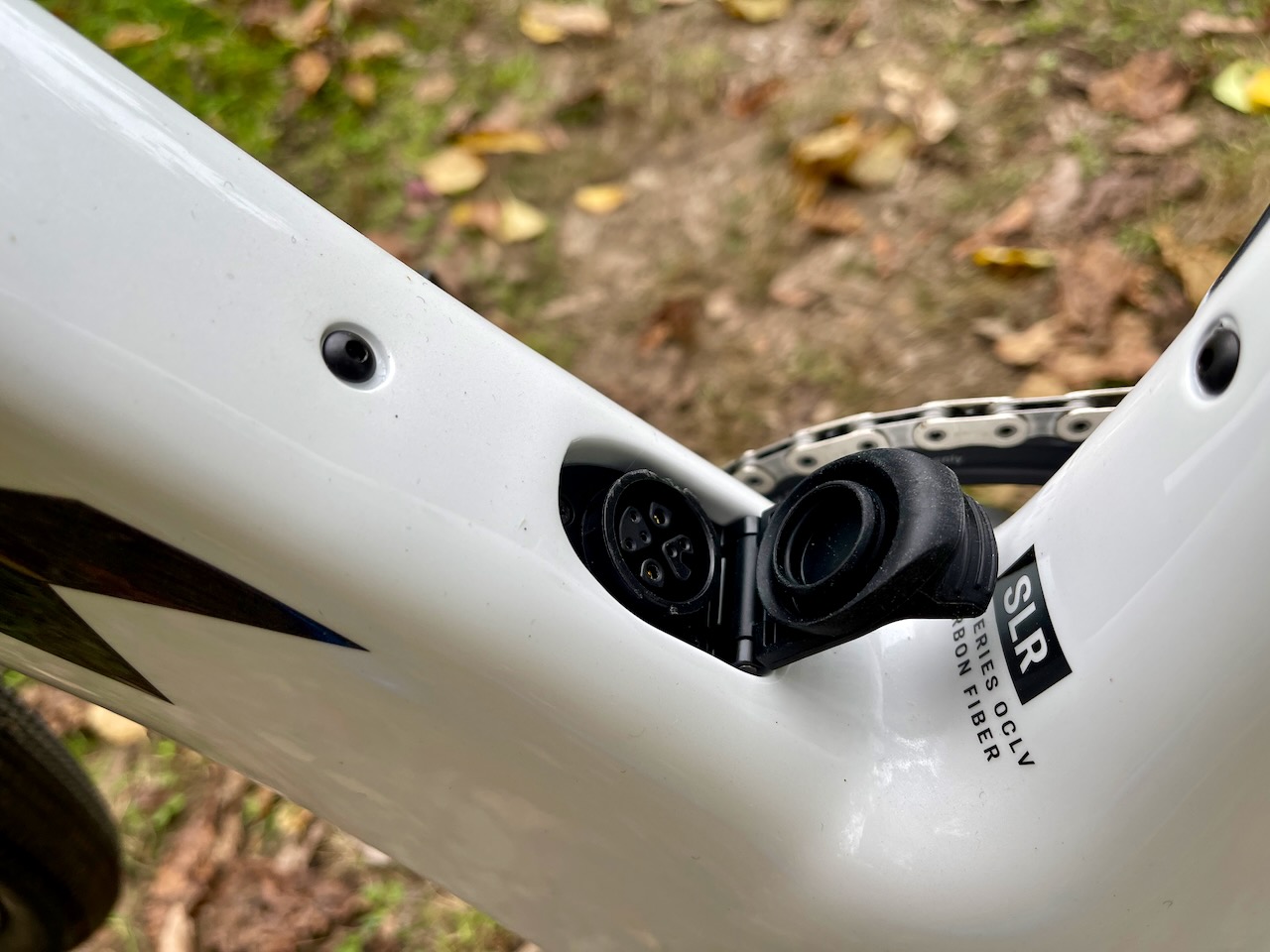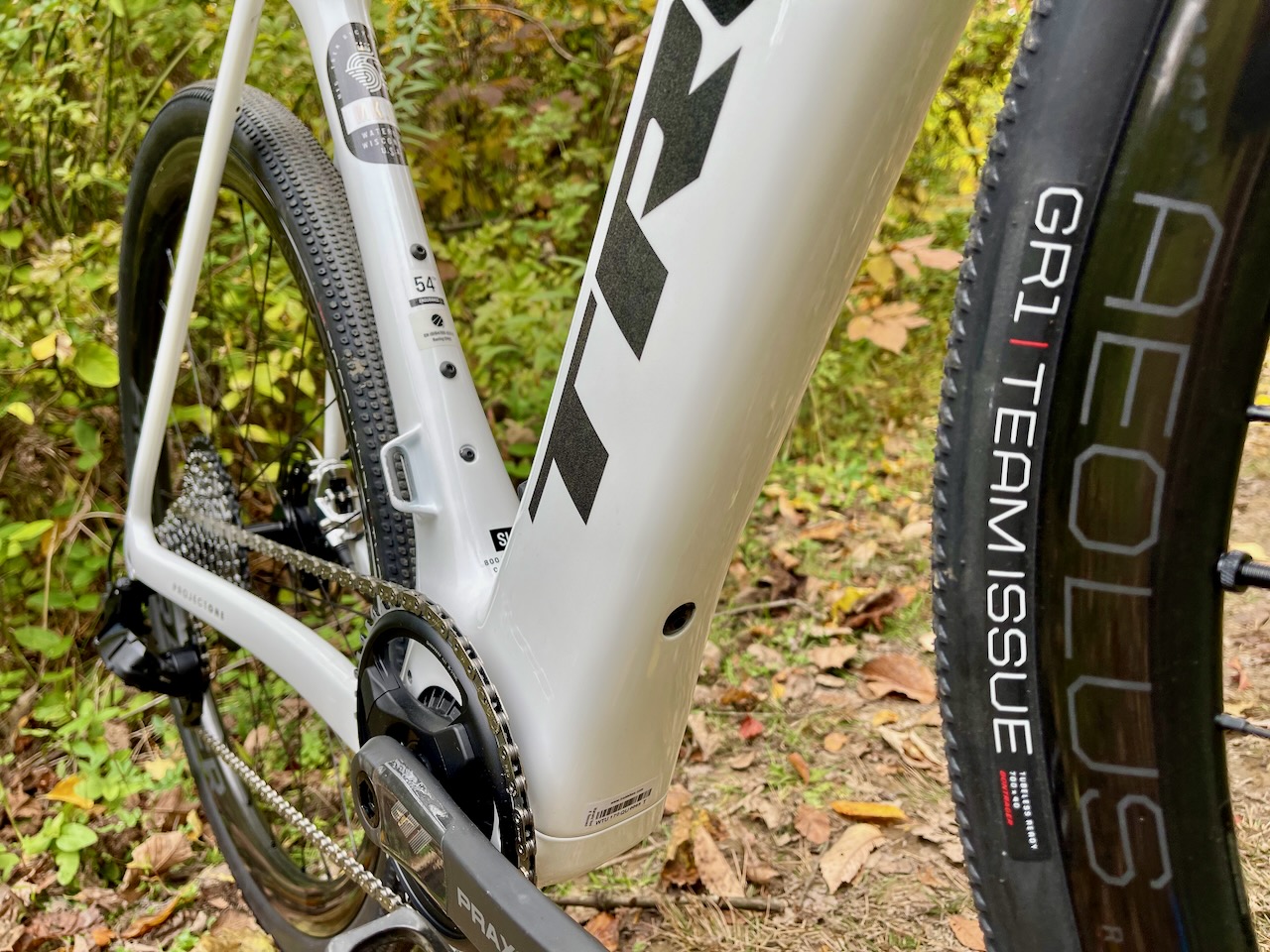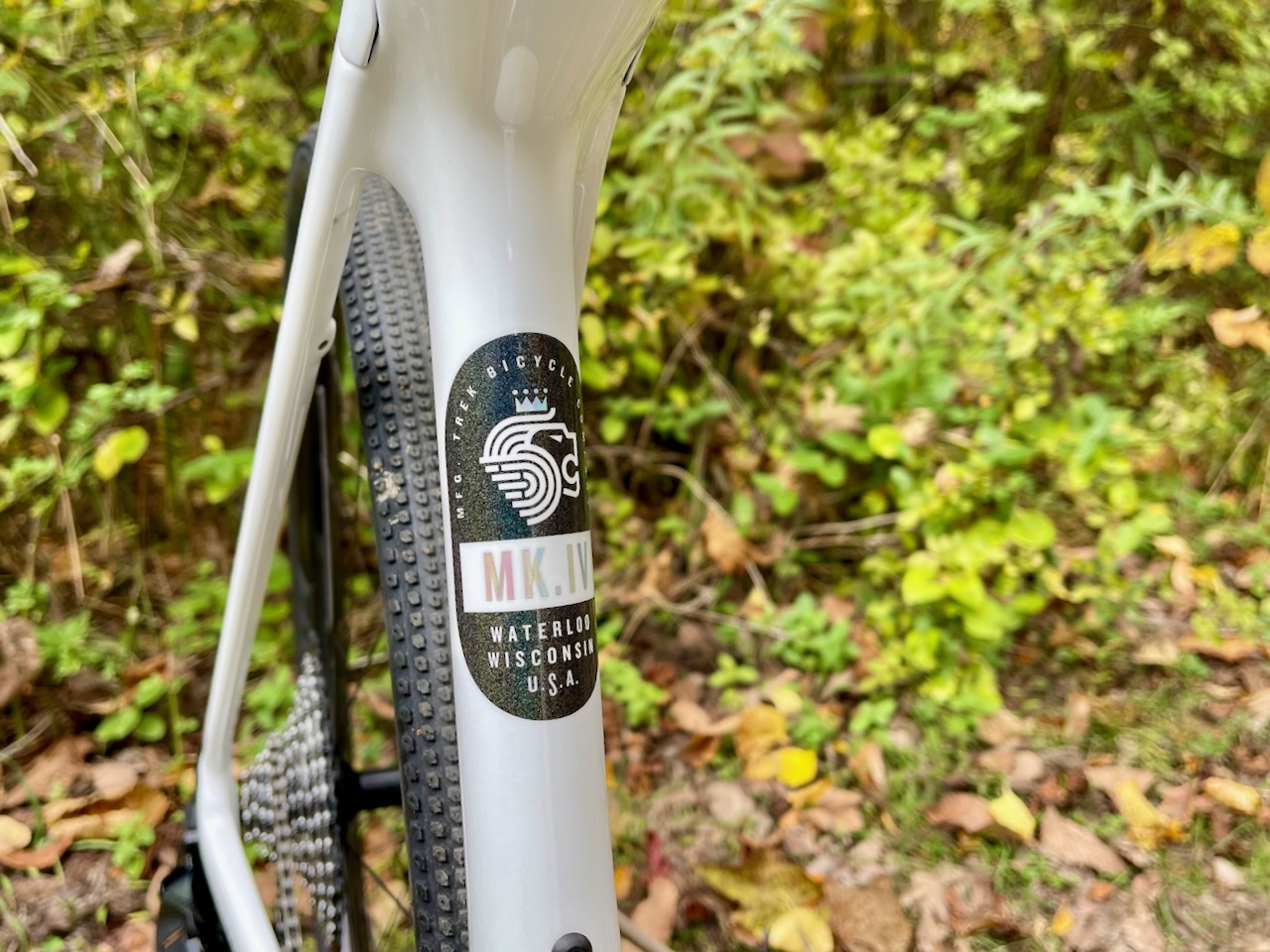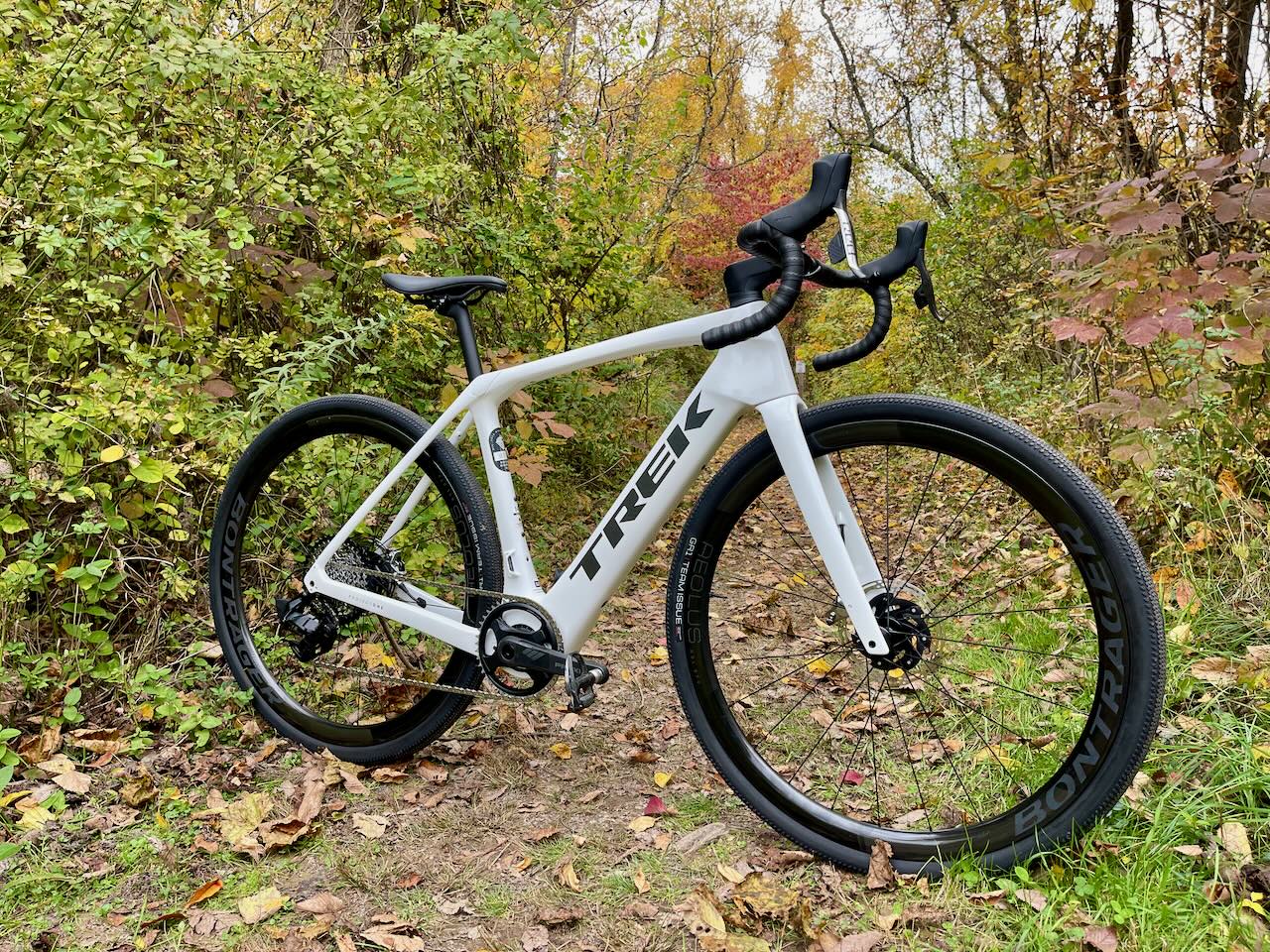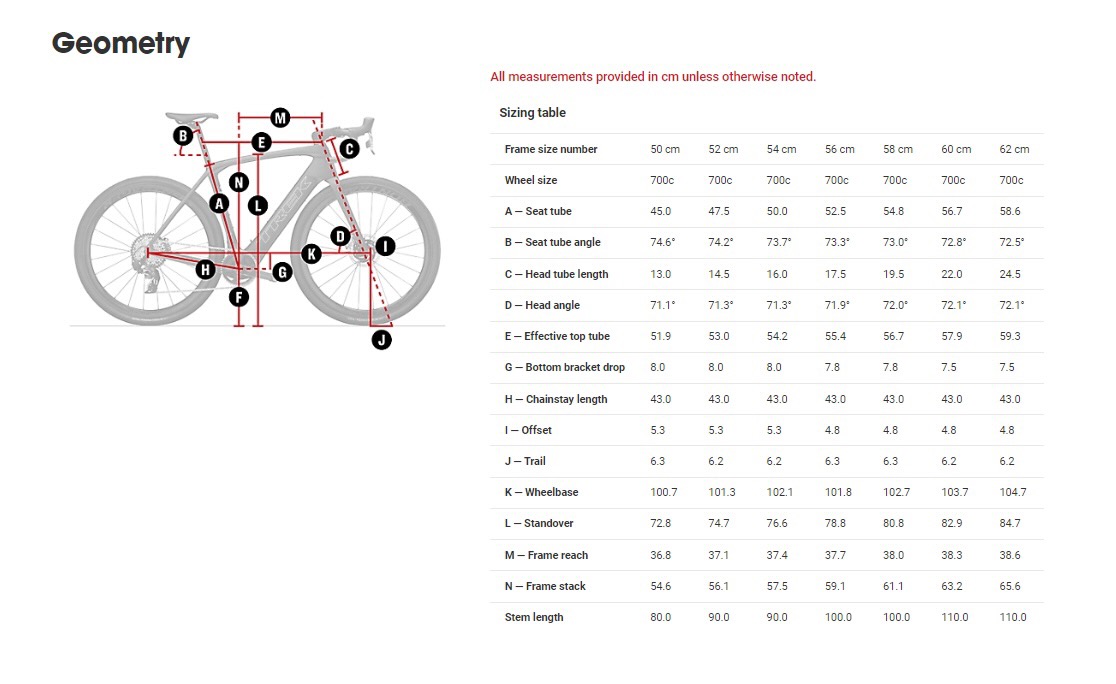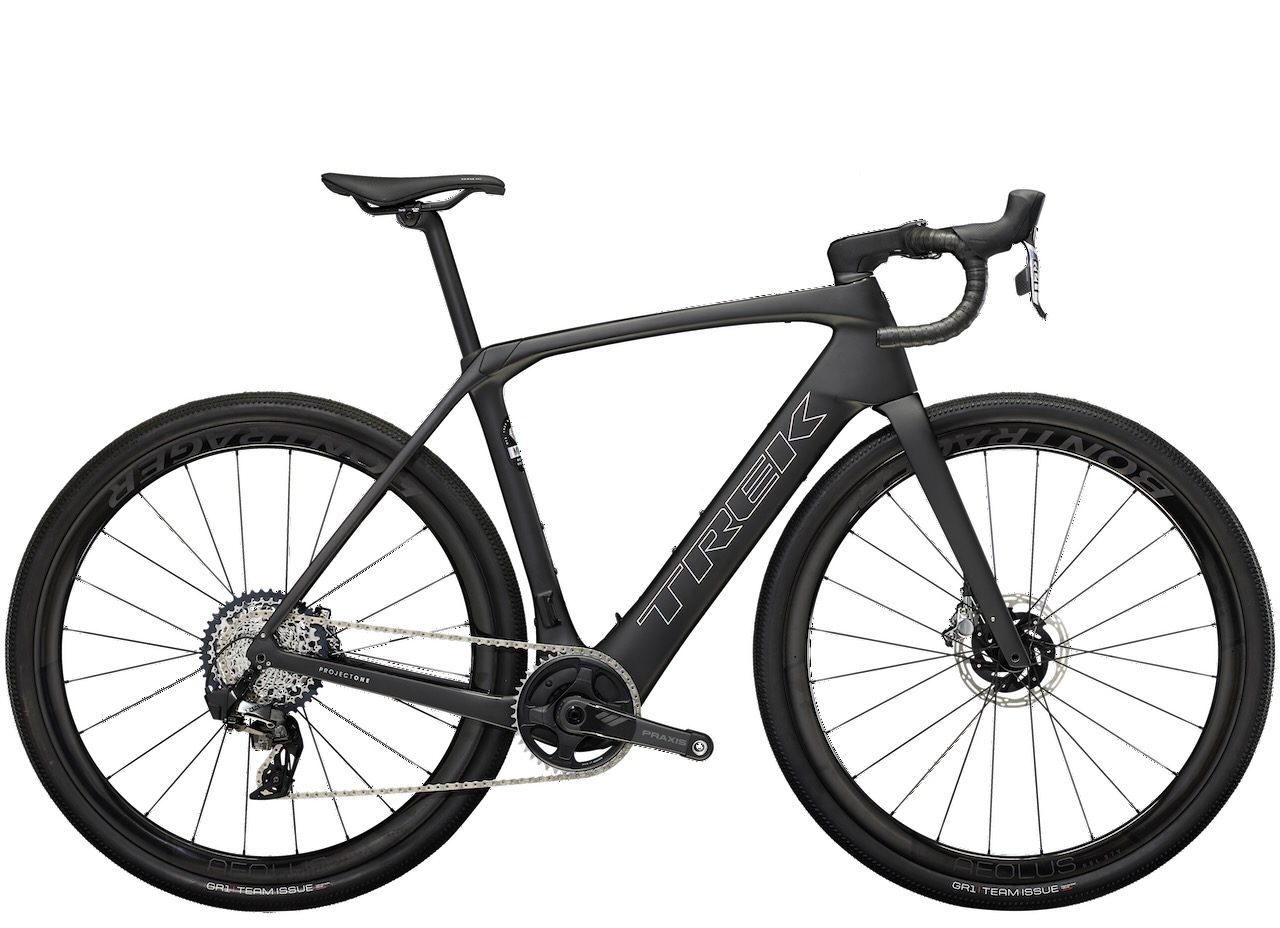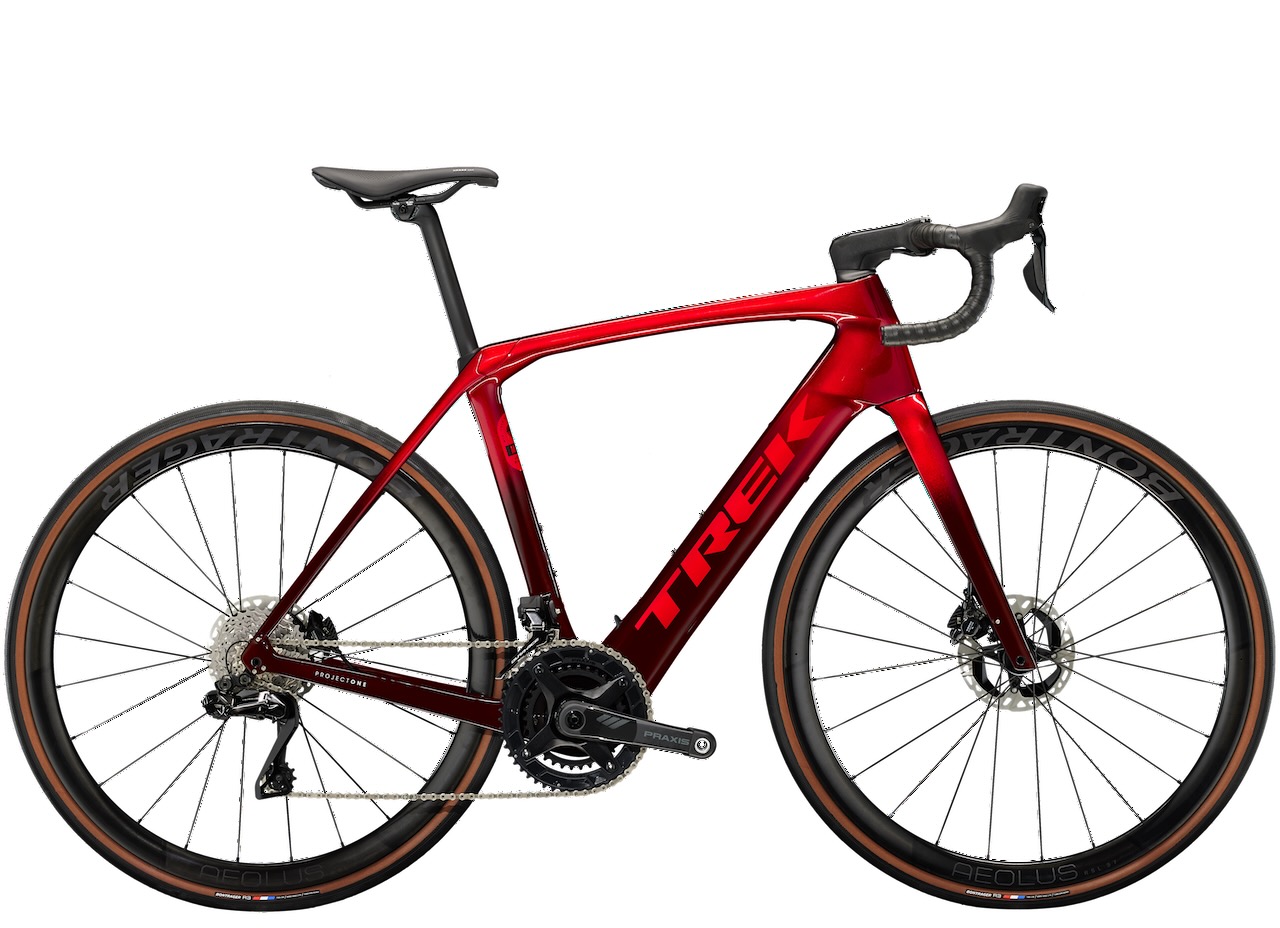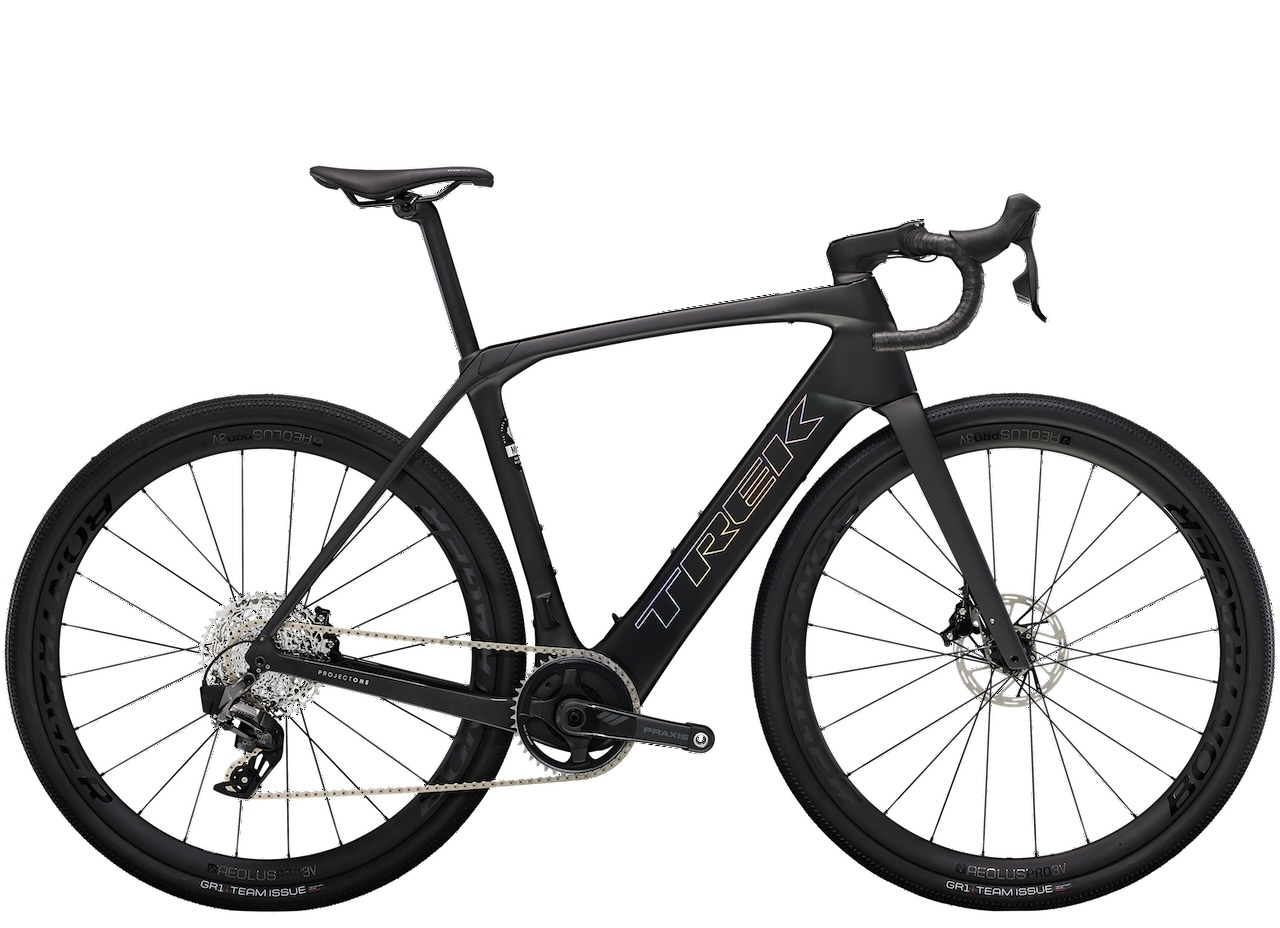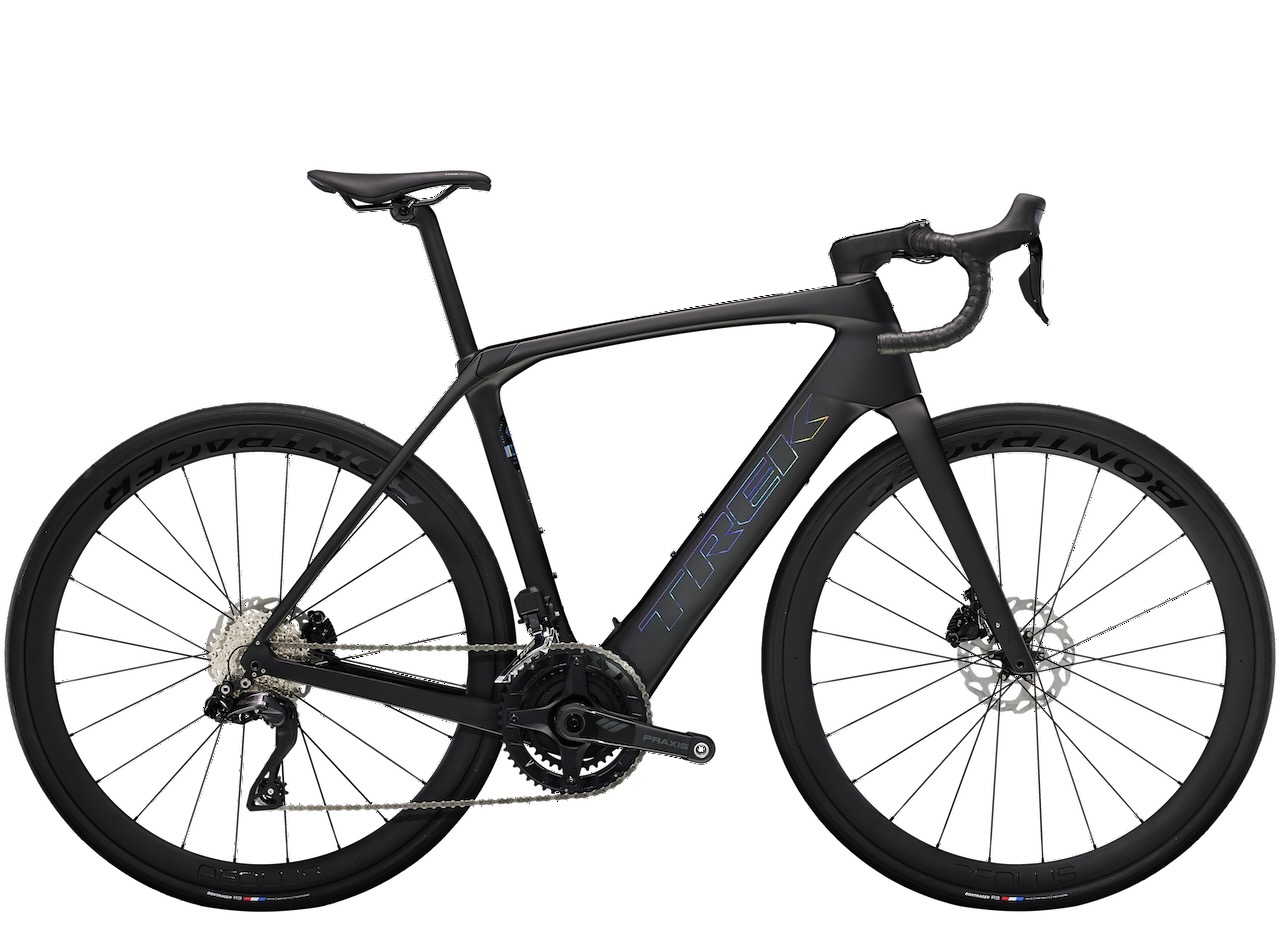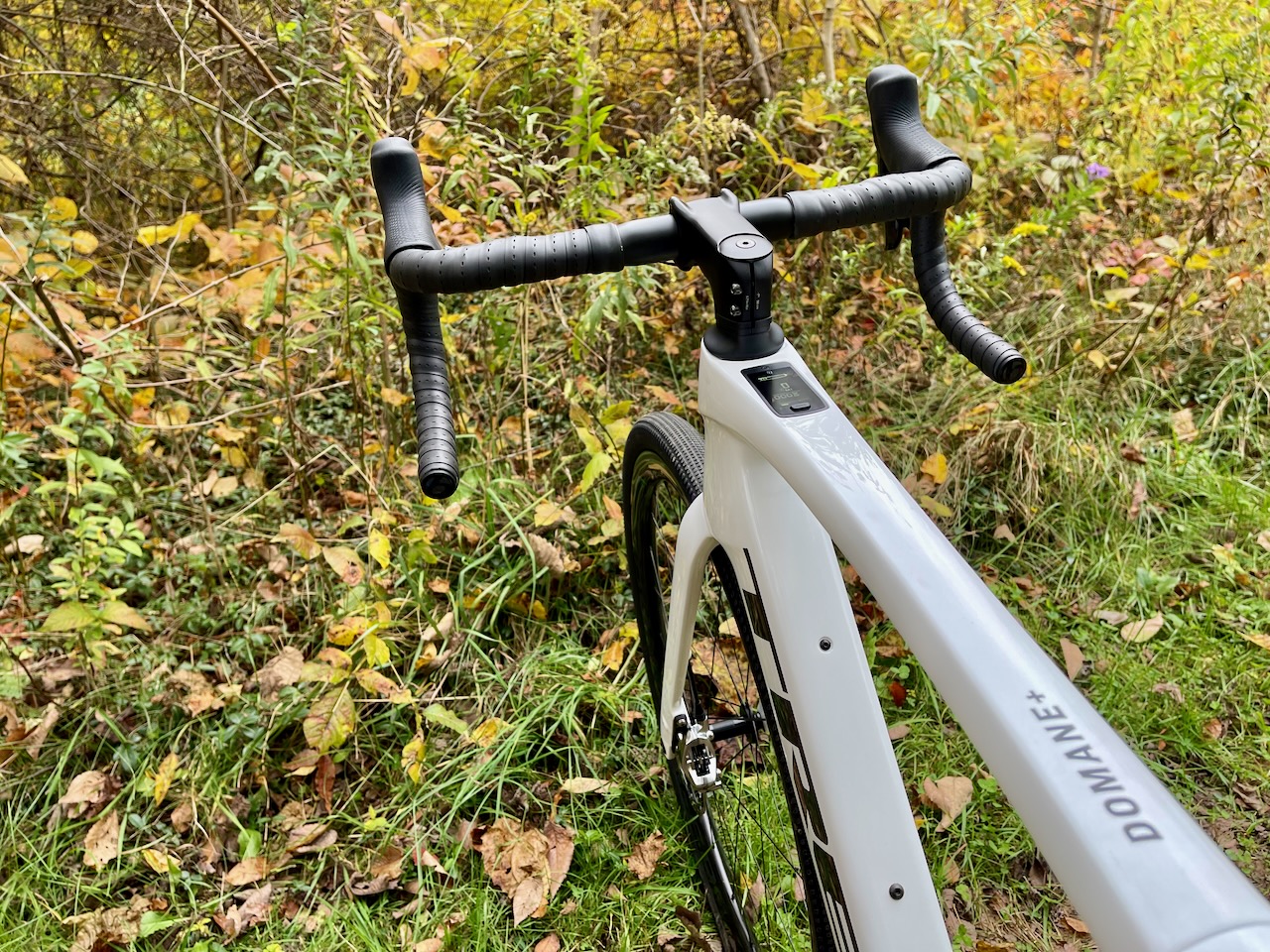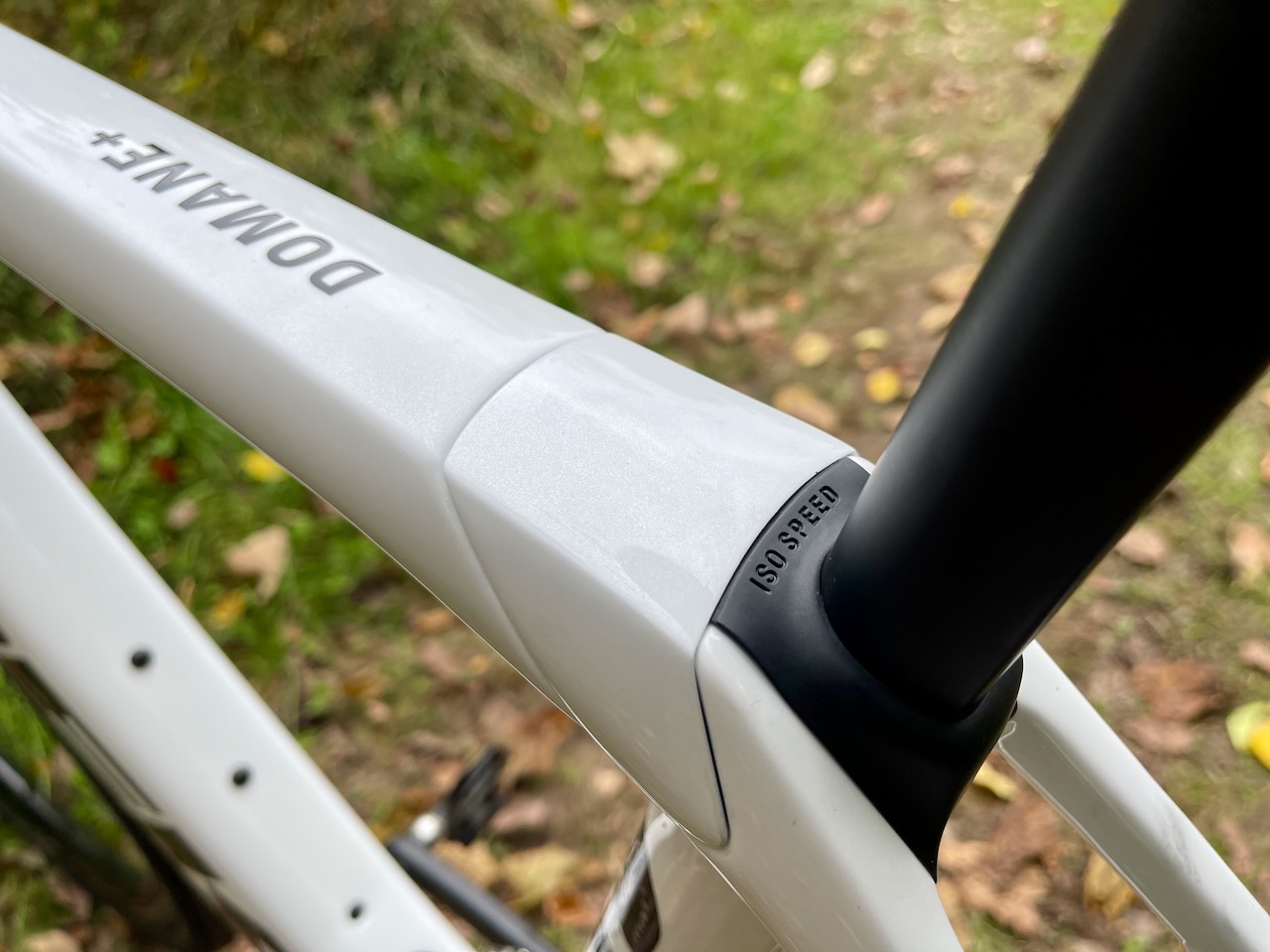Trek’s Domane+ SLR is genuinely an all-new animal for road riding. Trek uses its newly updated Domane frameset and the TQ (Technologie in Qualität) HPR50 to craft an all-road e-bike that feels traditional but is anything but.

The design focus for the Domane+ SLR was to create an e-bike with natural road bike sensations with a seriously impressive weight-to-speed ratio. The lightest offering for the Domane+ SLR tips with scales at around 25.90lbs with a 28 mph (25 km/h in Europe) max assist.
Trek Domane+ SLR
The mission of the Domane+ SLR is to give a road bike experience with a featherweight frame and a boost when you need it. To give the rider that needs an extra push for the adventure they dream of without the extra weight of a traditional e-bike. The Domane+ SLR doesn’t look, sound, fit, or feel like an electric bike, and that’s exactly what Trek wanted.
Domane+ SLR — 800 series OCLV carbon
A significant change in design for the new Domane+ SLR is the decision to use Treks’ 800 series OCLV carbon. The 800 carbon series is Trek’s top road and performance line carbon. The move to 800 series carbon allowed the design team to craft a lighter frame by eliminating excess carbon around the battery (more on that later) and harness a better overall ride quality.
The new Domane+ SLR frame features 100×12 mm front, and 142×12 mm rear spacing, with mounts for fenders and small accessories. The frame does not come with internal storage like the acoustic Domane but should fit all manner of frame bags easily.
For those that heed the call to adventure, take note the tire clearance grows from a generous 35mm for the acoustic Domane to 40mm for the Domane+ SLR. The Domane+ SLR 9 eTap pictured above supports a 40mm Bontrager GR1 tire mounted to a Bontrager RSL 37 rim with a 21mm internal and 26mm external.
Assist modes: Ride far, ride fast, ride often
Domane+ SLR has a max assist of up to 28 mph, with a 360-watt/hour battery. That range can take riders around 60 miles in Eco-mode or around 90 miles with the optional 160-watt/hour Range Extender.
The Domane+ SLR comes from the factory with three assist modes; Eco, Mid, and High. You can now customize each mode and plan routes in the new Trek app. The app also allows you to see how far your current battery charge will take you and allow you to make adjustments to the assist, ensuring you get to the end of the ride. Though the app works great, the integrated top tube display is in plain sight and will give you the ride details when needed.
What’s the motor?
If you saw the new Trek Fuel EXe announcement, we’re guessing you know which motor comes on this new Domane+. The TQ-HPR50 harmonic pin ring e-system motor. This motor is remarkably lightweight (3900g), tranquil, and gives a boost without the lurch of some e-bike motors.
What is a pin motor? In a nutshell, most e-bike motors use gears and belts to transmit power. These parts take up more space and can make noise or break. The HPR50 uses a harmonic drive transmission that’s small, simple, and dependable. To learn more about the workings of the new TQ motor, check out our deep dive into the TQ HPR50 here.
Using the TQ motors, designers employed a close-to-standard road Q factor of around 163mm. This narrow Q-factor helps riders from a traditional road bike make the switch naturally and not feel like riding a horse or fat bike.
Assist at the shifter
Trek opted to move the assist mode adjustment closer to the shifter, helping riders keep their hands in one place, making for an immaculate presentation. The intuitive mode control buttons on the hoods and road-specific tune give Domane+ SLR a traditional road bike fit and feel while still providing a natural-feeling boost.
Where is the battery?
I asked this question when our review bike arrived; the simple answer….was it’s IN the frame (best Zoolander voice). Having the battery molded into the frame of the new Domane+ SLR allowed the design team to cut weight (carbon and battery fittings) and make the frame as sleek looking as possible.
Can you remove the battery? Trek says an experienced home mechanic can remove the battery in 15-30 minutes “Remove the drive unit cover, remove the drive unit, remove the screws that hold the battery charge port in place, remove the battery.” If that sounds like too much wrenching for you, your local Trek retailer is happy to help.
Need more battery? The mileage you get from each battery varies on many factors, such as rider weight, assist level, tire choice, riding surface, terrain, and more. If you’re looking to go longer than the frame battery can take you, Trek offers a Range extender battery that can add around 30 extra miles to your ride. The Range Extender battery sits in the water bottle cage and weighs around the same amount as a 26oz full bottle. The Range Extender plugs into the charging port and keeps the wires nice and tight to keep your pedaling smooth. For added security, Trek includes a strap to help stabilize the Range Extender for those long days exploring the gravel.
Domane+ SLR Geometery
The geometry for the Domane+ SLR is almost exactly the same as the Trek Domane “endurance” or H2 geometry. The Domane+ SLR frame has 10mm longer chainstays (43cm vs. 42cm on a 54cm frame). The longer rear gives the Domane+ SLR a planted feel in the corners and on the road. A longer wheelbase is good because the speeds you can hit on the flats with the TQ motor may be unfamiliar territory to some riders.
The H2 geometry features a higher top tube and a slightly longer wheelbase to give the bike a stable feel no matter the terrain. The all-new Domane+ SRL frames boast a wide range of sizes, starting at 50cm and ending at 62cm.
Trek Domane+ SLR Specs, models, and weights
The Trek Domane+ SLR frame is electronic shifting only, so the shifting offerings are all top-notch. Each model comes in a Shimano Di2 or SRAM eTap configuration. The SRAM option employs a single front ring, while the Shimano uses a double.
The top offering Domane+ SLR 9, arrives with either SRAM eTap RED (single front ring) or Shimano Dura Ace 12 speed with a double ring set-up.
The line trickles down from Di2 Ultegra 12 speed and SRAM eTap Force for the Domane+ SLR 7 and Shimano Di2 105 or SRAM Rival eTap for the Domane+ SLR 6.
The Shimano spec is slightly more road-focused, with narrower 32mm tires, and the SRAM with 40mm gravel-ish ones. You can choose your density for your Domane+ SLR as they all come with Bontrager Aeolus RSL 37 wheels, a BikeRumor staff favorite for its super lightweight and versatility.
Each Domane+ SLR, no matter what configuration, comes with the same base frameset, though the Project One offerings have a flashier paint job.
- Trek Domane+ SLR 9 Project One eTap (tested): Price: $13,000, Weight: 27.03lbs* actual
- Trek Domane+ SLR 9 Project One Shimano: Price: $13,000, Weight: 25.90lbs
- Trek Domane+ SLR 7 Project One eTap: Price: $10,000, Weight: 27.56lbs
- Trek Domane+ SLR 7 Project One Shimano: Price: $10,000, Weight: 26.90lbs
- Trek Domane+ SLR 7: Price: $9,500, Weight: 26.90lbs
- Trek Domane+ SLR 6 Project One eTap: Price: $9,000, Weight: 27.78lbs
- Trek Domane+ SLR 6 Project One Shimano: Price: $9,000, Weight: 27.78lbs
- Trek Domane+ SLR 6: Price: $8,500. Weight: 27.34lbs
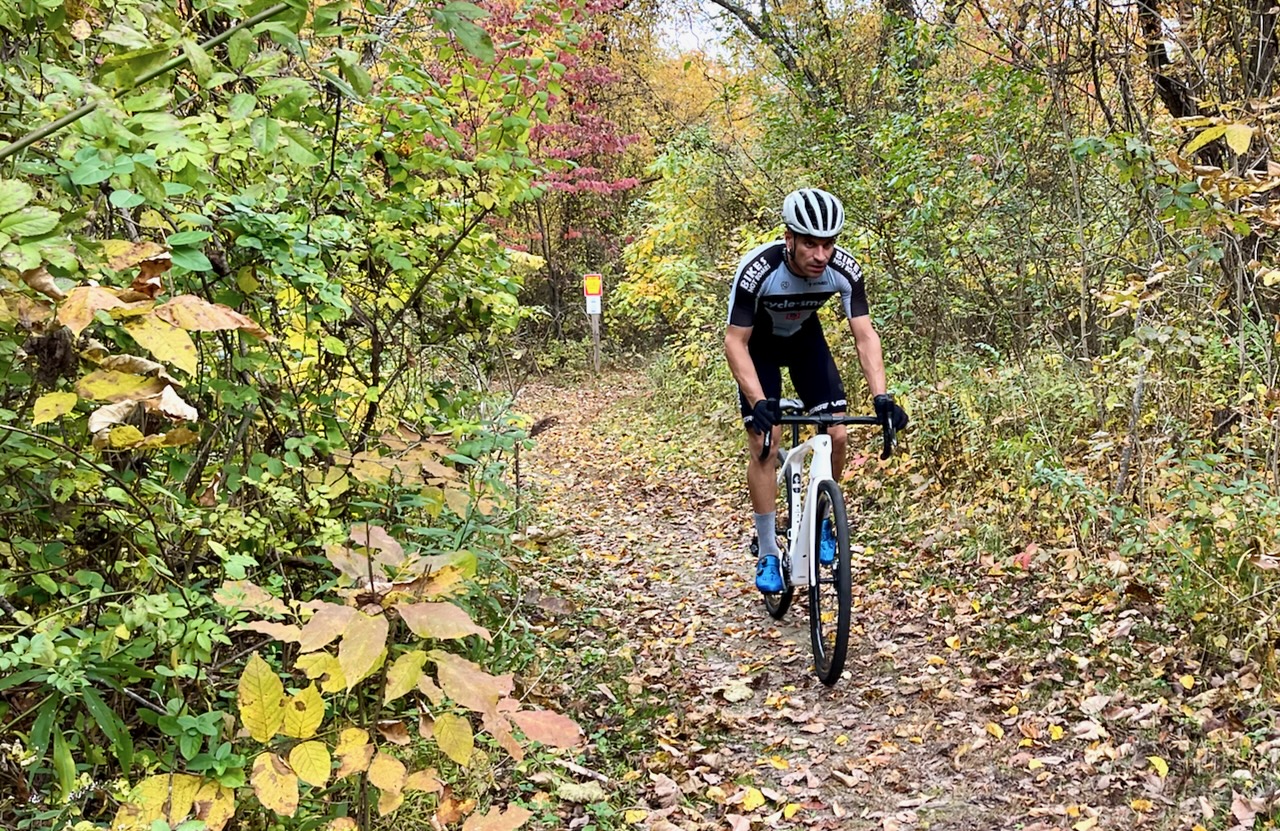
Trek Domane+ SLR 9 Project One eTap — Initial ride impressions
Out of the box, the Trek Domane+ SLR 9 looks like a regular road bike with a beefy down tube. Once you look closer, you notice the screen and the gearbox. Trek isn’t trying to “hide” the motor on the bike. They are attempting to make it feel more like an acoustic road bike. Maybe to make you think less about the motor and additions and more about riding the bike.
The Trek Domane+ SLR 9 was easy enough to pair with the Trek Central app, which is new from the launch of the Trek Fuel EXe with the TQ motor. The app acts as a riding partner, helping you dial in tire pressure, motor settings, and maps.
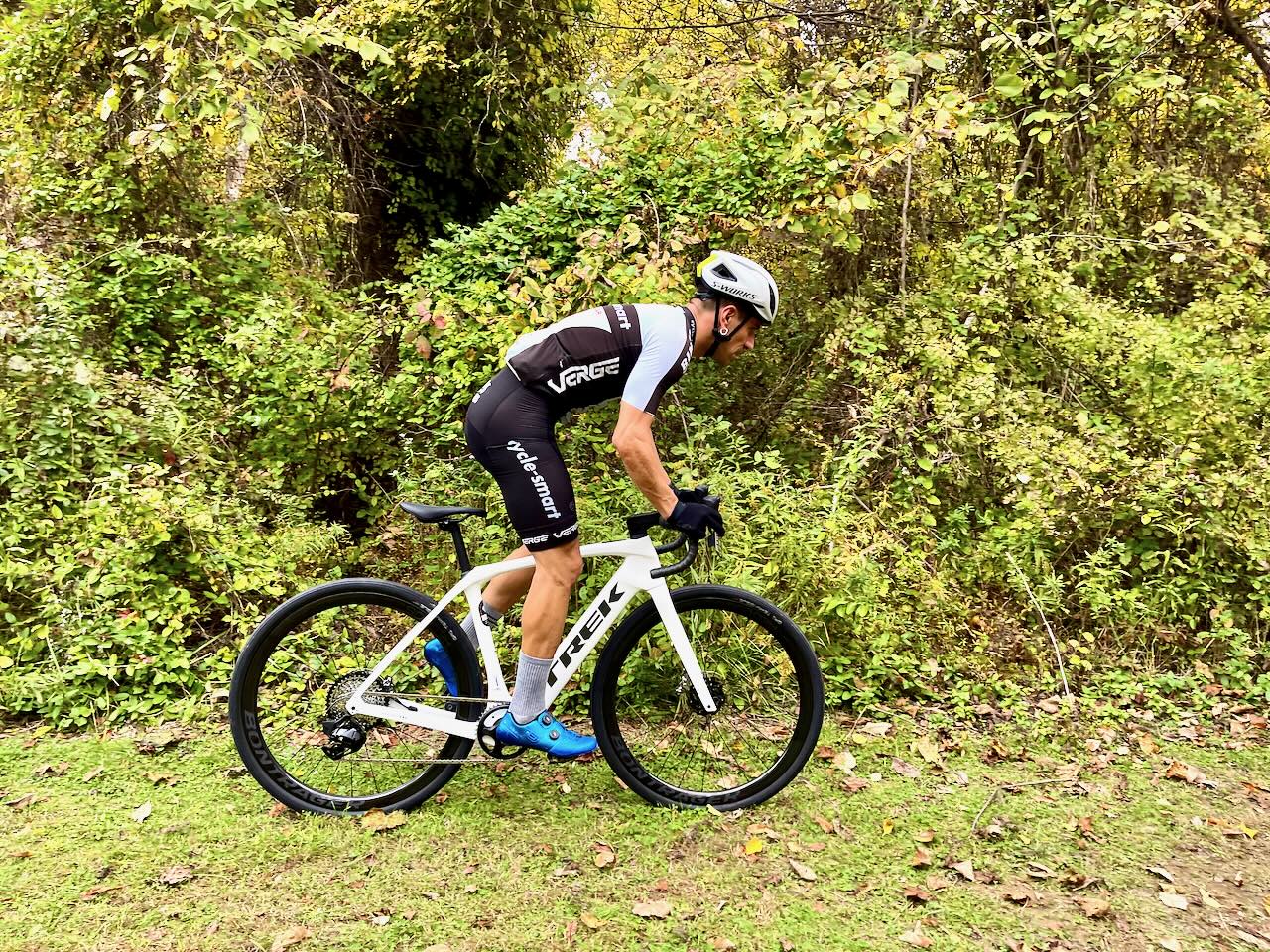
Trek Domane+ SLR 9 feels like an acoustic bike on the open road, especially while corning and riding tight roads. Most ebikes have a very bottom-heavy feel (like riding with full bottles vs. without). The Trek Domane+ SLR 9 doesn’t have any of these ride sensations. The fact that it feels more like a traditional road bike makes you want to push the limit in corners and on the flats. The Domane+ geometry is right in the sweet spot for stability and spark when you need it.
The IsoSpeed damper is a perfect addition to the Trek Domane+ SLR 9; with the 28mph speed threshold, the bike can roll on the flats, and the IsoSpeed eats up the chatter.
I found adjusting the modes at the shifter to be highly intuitive; never having to take your hands off the bars is paramount on an e-bike with such speed capabilities. The top tube screen is bright and clear, enough to get all the necessary information. The bike worked well with the Garmin and Wahoo head units we used during our initial outings, plus the new Bontrager stems have a spot for out-front computer mount.
The Domane+ SLR will be available globally on trekbikes.com and through Trek’s global network of retail partners. We’re excited to get out more on the Trek Domane+ SLR 9. Look for a full review coming in the future. Until then, check out TrekBikes.com for more information.
